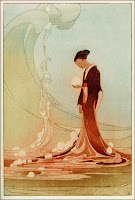There are two things that I find to be just unmitigatedly bad in old school Dungeons and Dragons: Turn Undead and treasure generation. I’m still working in the first, but I need a good, easy to use loot generator like two years ago, so here’s what I’ve cobbled together. Since I guess this blog is just a restatement of games with others, it’s based off of the generator here, and has a similar rationale–players are forced to explore more and more dangerous areas if they want to find treasure, gain XP, or even stay supplied.
the rules
When you loot a corpse or go through a room, roll 1d10+level+number of times you have already looted the area or corpse. This takes 1 Turn and a roll of the encounter die.
If you roll higher than the corpse’s HD or higher than 3+dungeon level, you just find junk and will only ever find junk.
If you roll equal to or less than that, compare the natural result of the 1d10 roll (so don’t add your level or number of items you have looted) to the Loot Table.
Black Sand is precipitated dream-stuff. It falls gently and diffusely everywhere in San Serafin, but in sufficient quantities it is of some value to various NPCs. Burning it at a campfire provides XP equal to its value.
Treasures come in several different types. Incense/candles can be used in barter with the Dead or burned on an altar for XP. Hearts can be used in barter with a devil or buried in a graveyard for XP. Coins can be used to trade with Serafinos, if you can get them to talk to you.
Bartering is dangerous, difficult, and kind of unfair, so scavenging for supplies is actually important–getting the gear result is not supposed to be a dud roll at all.
Loot Table
- Random gear
- Random supplies
- Black Sand (value = d100xHD of creature or d100xdungeon level)
- Treasure (value=d1000xHD or dungeon level)
- high quality gear
- secret/map fragment
- Consumable Magic Item
- Enchanted Magic Item
- a secret
- Artifact
Random Supplies (1d8)
- torch
- ration
- flask of oil
- lantern
- lighter
- 1d20 arrows
Quality Gear
- Compass
- Rapier
- Scimitars
- leather armor
- chain armor
- plate armor
- warhammer
- greatsword
- glaive
- longbow
- crossbow
- javelin
Consumable Magic Item
- MU spell scroll with level = ½ current dungeon level
- Cleric spell scroll with level = ½ current dungeon level
- Potion of Diminution: makes drinker mouse-sized for d6+1 Turns
- Potion of Polymorph
- Potion of Protection from Heat
- Potion of Protection from Cold
- Potion of False Death: appear as undead, even to the undead, for d6+1 Turns
- Potion of Sanctuary
- Potion of Waterbreathing
- Potion of Cure Light Wounds
- Potion of Dragonbreath: make a breath attack as a red dragon; deals damage equal to your current HP
- Potion of Cure Disease
Enchanted Magic Item
- Pyromantic Sigil: once belonged to a pyromancer betrayed by his own children. Allows the wielder to cast a fiery version of Magic Missile. Has a 1 in 10 chance of failing with each use, but can be recharged with a bottle of Midnight Oil.
- Scales of Shaday: Once belonged to a cleric who was declared anathema for violating the course of history. Allows the wielder to Detect Magic and Detect Evil at will.
- Viper-embroidered Veil: lost by a thief renowned for her virtue. Allows the wielder to cast Invisibility on themselves 1/hour.
- Ring of Ages: once belonged to a powerful alchemist who committed a terrible betrayal to attain eternal life. The wearer does not age so long as they wear it.
- Mask of Granosa: created from a beast god’s corpse by an evil mask-maker. Wearer grows sharp claws and fierce fangs and can make unarmed attacks as a grizzly bear (1d4/1d4/1d8)
- Six Ways To Sunday: a six-shooter machined by a hated exorcist. Can only be fired 6 times a week; recovers all of its ammunition on Sunday at noon. d12 damage at longbow range, ignores AC provided by armor
I’m keeping Secrets and Artifacts under my hat.
This isn’t the only way to get treasure. There are various NPCs with unique spells, items, and classes you can’t get anywhere else, but they have to be discovered and courted.













